by Dr Andrew Black[*], Associate Director, Global Policy Institute, assisted by Luisa Borras
“It’s not the voting that’s democracy; it’s the counting.”
Tom Stoppard
Introduction
Amongst many crises affecting the UK currently, there is one that has a long fuse, has been burning for some time, and has the power to blow the United Kingdom to pieces. This paper explores how nationalism has affected, and been affected by the last four general elections, running from 2010 to 2019. Electoral results have been analysed in order to establish which regions have supported various types of nationalism. And in so doing this has cast a rather different light on recent political developments in the UK. The findings support the contention expressed by the Constitutional Society, cited by Peter Walker in the Guardian, that “an increased concentration of support for the two main parties into defined geographical areas means there was less and less direct competition between Labour and the Conservatives, negating a need to appeal to the middle ground”. Indeed, the Report argues that the First Past the Post System (FPTPS) empowers more extreme voices within both the Labour and Conservative party membership. And if a more extreme group, such as one espousing English nationalism, “captures” one of the main political parties, FPTPS then cements their grip on power nationally. As is shown below, something like this appears to have happened.
In order to show the interactions between nationalism types and the FPTPS, a summary of the different political forms of nationalism is shown below. The goals of these nationalist political parties differ widely. Some of them are not supportive of a continuation of the UK in its current form.
Differing colours of nationalism in the UK
Nationalism can be found in many different locations and in many different guises. Defining it is difficult, engaging the minds of many scholars, philosophers and analysts including John Stuart Mill, Rousseau, Herde, von Fichte to name just a few.
Chart 1
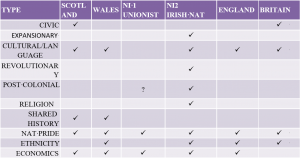
Eleven features of nationalism are shown in chart 1. Some are closely related to each other, while others remain more distinctive. The ticks indicate areas where the features are found in the various nationalisms extant in the UK. The combinations of these features constitute social identity groups, groups of individuals who self identify as having nationalist opinions. Nationalist groups frequently dislike each other, and group members tend to think in terms of “us”, the in group members, and “them”, outsiders, often regarded as being inferior.
Chart 1 provides a schematic overview of the different types and views on nationalism. It shows how the various strands on nationalism found in the United Kingdom relate to these various nationalist features. Nationalism evolves and changes its form over time. These changes are both the outcomes of complex social forces and at the same time help to shape them. For example, Scottish nationalist feelings are now broadly distributed across Scotland. Yet the results from two recent elections show how, in this case, the SNP has benefited from FPTP, and which exaggerates its position within the electorate. In the 2019 Westminster general election, the SNP, with 45% of the vote, gained 48 seats, or 81% of all Scottish seats. In the 2019 Holyrood election, the SNP with 40.3% of the votes won 49% of Holyrood seats, a result that more accurately reflects its share of the popular vote. The weakness of FPTP is that it is less democratic. In Scotland, Labour’s share of the Scottish vote in 2019 was 18.6%, resulting in winning a single constituency. In the 2021 Holyrood election, Labour’s 17.9% share of the popular vote resulted in it winning 24 seats – a more democratically representative result.
There are currently six different types of nationalism in the UK, sharing a number of features. Scottish nationalism is sometimes described as a civic form of nationalism. It is inclusive, and all are welcome to join and participate in civic life. Scottish nationalism is not ethnically based, and has a left-wing element in terms of enhancing social policies that are more collective and egalitarian than in England. (See LSE blog). Growing impatience with the slow pace of reform in Scotland led to a Scottish referendum in 2014 on Scottish independence, thus preceding the Brexit referendum. The referendum was won by unionists, those who wanted to retain the current arrangements with England. The victory by the unionists was assisted by a last minute effort by the leaders of the 3 main political parties in England to agree to transfer additional powers to the Scottish Parliament. While this was partially achieved with the Scotland Act in 2016, Scottish nationalists argue that the Act’s overall impact was severely reduced by the Brexit referendum result. Scottish nationalists point to a loss in Scottish sovereignty, since Scotland’s clear vote to remain within the EU was over-ridden by the overall UK decision to leave.
However, the referendum and its associated campaign greatly influenced the rise of English nationalism, and the emergence of UKIP, who went on to receive nearly 4 million votes in the 2015 UK general election, without winning a single seat in the House of Commons, due largely to the biases involved in the FPTPS, which worked against English nationalists. The Unionist parties in Scotland, sections of the Labour and Conservative parties, were seriously weakened in the 2015 General Election that followed, thus leaving Scottish parliamentary representation more nationalist than ever.
Welsh nationalism is more focused around cultural and linguistic elements, and has an ethnic dimension. Support is more geographically dispersed than in Scotland, with Welsh Nationalism being stronger in mid and north Wales than in the South. Wales voted to Leave the EU.
Northern Ireland nationalism has two forms, NI 1, the Unionist group, and NI 2, the Republican group represented by Sinn Fein. Northern Ireland is unique in not having a nationalism that stands for the entire province. Tensions between the two forms of Northern Irish nationalism have led to violence, requiring military intervention to restore law and order. A new chapter of cooperation between the two nationalist groups emerged in 1997. After the election of New Labour, the new government moved swiftly to defuse communal violence. The Good Friday Agreement was signed between the two nationalist groups, the British and Irish governments, with the US and EU providing further encouragement. This period appears to be now under threat, largely because of Brexit related difficulties. Demographic changes in Northern Ireland mean that Republican supporters may in the foreseeable future form the majority of voters[1]. Given the mechanisms of the Good Friday Agreement to call for a referendum about the land border between the North and the South, it is entirely possible that Northern Ireland could, effectively, vote itself out of the UK at some point in the future, effectively by passing Westminster. The northern Irish nationalisms are ethnic, and have cultural and linguistic elements. The economic prospects for Northern Ireland have slipped behind those of the Irish Republic in the south, providing further support for remaining in the EU.
Finally there is English and British nationalism. According to the Economist, “English nationalism is the most disruptive force in British politics” (Economist 18/03/21. Bagehot). It has arisen as a result of several factors. One of these has been a decline in the attractiveness of being British. In the 2011 census, 57% of respondents identified themselves as being solely English rather than British. Certain symbols of Britain, such as the Union Jack flag have been steadily replaced by the English nationalist red cross of St. George on a white background. The national anthem has become replaced by local national anthems in the devolved nations. English nationalism has a strong ethnic element, and English nationalists are against immigration and immigrants. They are frequently bigoted and xenophobic. Many English nationalists are attached to the idea of an English parliament, and are hostile to the financial support given by Westminster to the devolved nations. According to recent opinion polls, 2/3rds TWO THIRDS of self-declared English nationalists would be happy to see Northern Ireland leave the Union, and many would support Mr Farage’s contention that the Scottish tail is wagging the English dog, leading to unfair advantages for Scotland at the expense of England. English nationalists are strong Leave supporters. They stand behind a version of Westminster and favour reinforcing English sovereignty. They have a pride, and some sense of nostalgia for the loss of former Imperial advantages. English nationalists have a sense of grievance and of being “left behind” by English/British society. The areas of strongest support for English nationalism are often coastal towns and small towns that are in relative economic decline. Many English nationalists are drawn from the elderly who are sometimes more prosperous, and from those less well educated. They see themselves frequently as the victims of “progress”, and tend to blame their fate on foreigners, including citizens of the EU.
English nationalism is partially replacing earlier support for being British. In recent surveys around 1/3rd ONE THIRD of those asked identified themselves as being English, compared with 47% who identified themselves as being British. British-ness is seen as supportive of the status quo, which itself is being increasingly challenged by English nationalists, who feel disadvantaged by it. Rising nationalism in the Devolved Nations then creates further tensions. British nationalism is closely identified with supporting the monarchy, the houses of parliament, the judiciary and other elements of the institutional status quo. Support for these British elements is being questioned in the devolved nations.
While many acknowledge that the mixture of these various forms of nationalism creates a dangerous political brew, the impact of nationalist forces has affected the outcomes of general elections more strongly than many imagine. In the rest of this paper details of nationalism within the British Isles will be clarified. And by combining survey material on the intensity of nationalist feelings obtained from British Social Attitudes and YouGov, together with analysis of the electorate and voting patterns obtained from the ONS and House of Commons, a picture of the location and strength of the various types of nationalism becomes clearer.
The Electorate & Nationalism
Chart 2

As the UK population slowly grew, so did the number of votes cast. Population growth is largely driven by international immigration. The number of registered voters is a product of the number of ‘attainers’, those reaching 18 years of age, and those who respond to requests to join the electoral roll issued by local councils. Success of the FPTP system can be observed by its rise in relative popularity, measured by the number of voters, and the propensity of voters to actually vote. For those who recall the enthusiasm engendered by the 1997 election of New Labour, 31 million votes were cast. This number was not exceeded until 2015. And while the eligible UK voting population continued to grow, between 2010 and 2015 the number of eligible voters in England fell.
Chart 2 shows that voting propensity (voter turnout) was falling since WW2. With the return of peace, turnout ratios of over 80% were scored. Voting propensities have been falling since the mid 50s, with occasional peaks and troughs. The red dotted line shows the fitted linear trend up to 2019. High voter enthusiasm in 1997 translated into a voting propensity of just over 70%. As the chart shows this ratio has not been exceeded since, as voter turnout drifted down into the mid 60 % mark. Considering the period between 2010 and 2019, voting propensities in the regions mainly increased from 2010 to 2017, before falling between 2017 and 2019. London and the North East were the only two regions where voting propensities increased in 2019.
Intensity of Nationalist Opinions
Chart 3
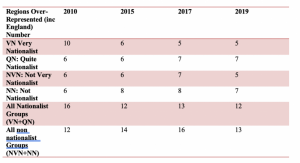
Sources: ONS NUTS2 regional statistics, British Social Attitudes/YouGov opinion poll surveys, authors calculations.
The strength and intensity of nationalist feeling varies across the UK. Chart 3 shows the regions where there are greater than the national average numbers of nationalists voters present between 2010 and 2019, in other words where nationalists are over-represented. Thus in 2010 there were 10 regions where there were greater than average numbers of Very Nationalist voters. By 2019, the number of regions where VN voters were over-represented had fallen to 5. If the Very nationalist (VN) and Quite nationalist (QN) groups are combined into one nationalist bloc, then the number of regions where nationalists were over-represented fell from 16 in 2010 to 12 in 2019. And by 2019 there were more regions where non nationalists were over-represented (13), compared with nationalist over-representation (12). More details can be found in Black (2021).
The analysis above shows that at a national level there was no sudden spike in interest shown by the public in general elections around nationalist themes such as the issues of Brexit. It can be argued that between 1997 and 2010 there was a decline in voting propensity, possibly because many voters thought that the FPTP system made their individual votes irrelevant. The shock of the Great Financial Crisis was sufficient to bring out more voters who expressed their displeasure at the Labour government whom they held responsible.
The Politics of Nationalism and the dysfunctionality of the Westminster FPTPS
In this section we examine how underlying changes in the size and strength of nationalist feelings influenced political developments in the UK between 2010 and 2019. In particular we shall look at how FPTP influenced voter behaviour and basically created large pools of effectively disenfranchised voters who had no natural political “home” to support, since FPTP restricts diversity of political opinion within Parliament.
Challenge came as a result of the convergence of English nationalism and Euroscepticism. A rise in Scottish nationalism, as demonstrated by the electoral success of the SNP and the effort to win the 2014 referendum on Scottish independence, appears to have helped foment a wave of support for English nationalism, a force that became very disruptive.
Between 2010 and 2015 English nationalists votes more than tripled from under 1 million to just under 3.8 million, based on UKIP polling statistics. [2] However, the FPTP system prevented their main political organization, UKIP, from winning a single parliamentary seat. In one sense these were “wasted votes” in 2015. In another sense this had serious repercussions. A second upheaval occurred with the decimation of the LibDems, the junior coalition partner with the Conservatives in 2015. The LibDems supported EU membership, and were hostile to English nationalism. The coalition government effectively prevented the Conservatives from reacting to the English nationalist challenge posed by UKIP. However, in the eyes of the electorate the LibDems were also associated with the harsh austerity policies sponsored by Cameron/Osborne. These gutted public services and raised student fees. The rationale for this was to repair the financial damage caused by the Great Financial Crisis of 2008/9. In the 2015 election LibDem votes declined from nearly 7 million to just over 2 million. The number of seats won by the LibDems imploded, with many of them captured by the Conservatives.
The threat from nearly 4 million UKIP nationalist right wing voters encouraged the Conservative party to adopt more English nationalist policies that were not congruent with all Tory supporters. Prime Minister Cameron conceded a technically advisory but politically decisive referendum on EU membership in 2016 as a sop to the English nationalist right. The Tory leadership in 2016 led an insincere effort to defend EU membership by appealing to “Project Fear”, rather than more robustly arguing for the many benefits enjoyed from EU membership. The Brexit referendum was won by the English nationalist “Leave” faction by a narrow majority. However, since the referendum was only advisory, the actual paving legislation needed to secede from the EU had to go through the House of Commons as the sovereign body ruling the UK. For this the majority attained in 2015, with support from some Northern Irish Unionists, was inadequate.
The FPTP system in 2015 effectively excluded both English nationalist opinion, as well as more specifically pro-EU and internationalist opinion as represented by the LibDems. The Conservatives under their new leader, a ‘Remainer’, Mrs May, gambled on getting an increased majority when they called an election in 2017.
Chart 4 – Nationalism in Action: Swings & Roundabouts of UK elections
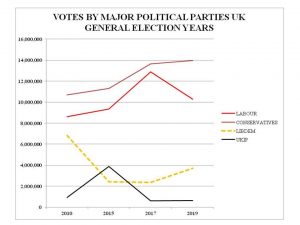
This was prevented by resurgent left-wing Labour votes. Labour gained 3.5 million votes in 2017, greater than the additional 2.3 million gained by the Conservatives. This shift by voters back to the two main parties was a response to the biases in the FPTP system that effectively excluded English nationalists against the EU, and English pro-EU voters, favouring international policies. The extent of the changes in the absolute number of votes recorded by the main English political parties is shown in Charts 4 and 5.
Chart 5

After 2015, voters realized that the only way of getting their opinions heard was by channelling their votes into one of the two mass parties, neither of whom were actually aligned to deal with the influx of nationalist and non-nationalist opinions. Both the main parties picked up votes from UKIP and the LibDems in 2017. However, this did not provide a resolution. The majority achieved by Cameron disappeared, leading to a period of 2 years of “parliamentary civil war”, as both sides of the Brexit divide fought to use Parliament to favour their cause while hindering that of the opposition. The FPTP system restricted the political choices available to the electorate, without providing mechanisms for resolving the situation. It was unable to widen the diversity of political interests existing in the country in a constructive way. Rather it favoured internecine warfare, as both the major political parties grappled with the EU issue around which neither had a firm consensus view within their own ranks. Chart 6 shows how votes were realigned in 2019. Although there was a small change in the votes received by the Conservatives, this was in stark contrast to the substantial increase in the majority gained by the Tories.
Chart 6
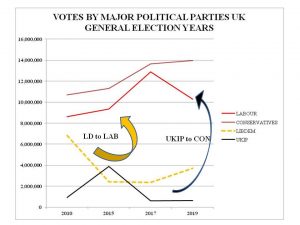
It is instructive to compare the straight jacket imposed by FPTP with what proportional representation systems can achieve. The German political system also faces pressures for change, over issues of immigration. Yet their political system has evolved from representing three strands of opinion, Christian Democrat (CDU/CSU), Social Democrat SPD and neo liberal Free Democracy (FDP) and has since adapted to include 6 political strands. None of these parties, and particularly the two larger ones, the SPD and CDU, have been able to successfully adapt to challenges presented by environmentalists (the Greens), challenges posed by German reunification and demands for a more egalitarian society (die Linke), as well as demands for a more nationalist solution from the right wing Alternative für Deutschland (AfD).
The Bundestag adapted to having 6 political parties, and in so doing remains more popular with voters. Voter turnout in Germany is nearly 10% higher than in the UK. The Westminster system has remained stuck in the twentieth century. And, until the arrival of UKIP, the main challenges came from the devolved nations, whose role can only ever be a minor one within the UK context. As the English nationalist threat emerged, so voters switched to shoring up the old duopoly, without realizing that factions within the two biggest parties would permit the political assassination of one Prime Minister by the European Research Group, and the nullification of any advantage Labour might have achieved by its 3 million additional votes, as it too was fundamentally divided on the EU issue.
And it is this that undermines the credibility of the FPTP system. The addition of 329 thousand votes for the Conservatives, combined with a reduction of 2.6 million votes for Labour converted in 2019 an absent majority to one of 88 seats. And this was achieved by political horse trading as UKIP votes morphed into Conservative votes, and some of the LibDem votes were spread across a range of smaller parties, who are discriminated against under FPTP.
The arrival of English nationalism as a political force has thrown up great questions about the sustainability of the FPTP in England. It is interesting that both Scotland and Northern Ireland changed to proportional representation systems in their “local” national elections, and there are signs that Wales may yet follow in elections to the Senned.
All of which is not to say that some nationalist parties benefit from the FPTP as has been shown by the case of the SNP above. Does this matter it might be asked ? At the very least non-SNP Scottish voices in Westminster will be barely heard. And it may exaggerate the influence of nationalists in the devolved nations in Westminster, weakening those groups seeking compromises.
Evidence presented here shows how widespread support for various kinds of nationalism is within the UK. These nationalisms are pointing in different directions. The Westminster system is becoming decreasingly relevant to those devolved nations seeking to secede from the UK. FPTP also causes serious problems facing new entrants into the cosy world of Westminster politics. Even with sizeable numbers of voters, FPTP discriminates against those parties that have broad cross regional support, and denies direct parliamentary representation to millions of voters who prefer not to vote for the two largest parties. This may yet lead to further tensions that could lead to the break-up of the UK.
Footnotes
[*] The author would like to thank Brunel Business School, the Co-innovate funding scheme, and the input and support of Dr. Grahame Fallon, and Professor Ashley Braganza.
[1] Sinn Fein now has the largest support for a single political party in N. Ireland. It is currently the most likely to form the next government in Stormont after the 2022 Stormont elections.
[2] Source: House of Commons Election returns.
References
Henderson, A , Wyn Jones, R “Englishness” (2021), OUP.
Kenny, M., “English Nationalism, the 2019 Election and the Future of the British State”, https://doi.org/10.1177/2041905820911744
Walker, P., “First Past the Post abets extreme politics”, Guardian, 23/4/20
David Klemperer, “The Electoral System and British Politics”, Constitutional Society 2019
Green, Elliot, “Scottish Nationalism Stands Apart”, LSE Blog (https://blogs.lse.ac.uk/politicsandpolicy/scottish-nationalism-stands-apart-from-other-secessionist-movements-for-being-civic-in-origin-rather-than-ethnic/)
British Social Attitudes (https://www.bsa.natcen.ac.uk/)
Office for National Statistics (https://www.ons.gov.uk/)
House of Commons Library, Election results for 2010,2015,2017,2019.
Bagehot, “The Disruptive Rise of English Nationalism”, Economist, 18 March 2021
Andrew Black, “Nationalism in the UK and its implications for the Westminster System of Governance “, Global Policy Institute, December 2021 (https://gpilondon.com/publications/nationalism-in-the-uk-and-its-implications-for-the-westminster-system-of-governance)

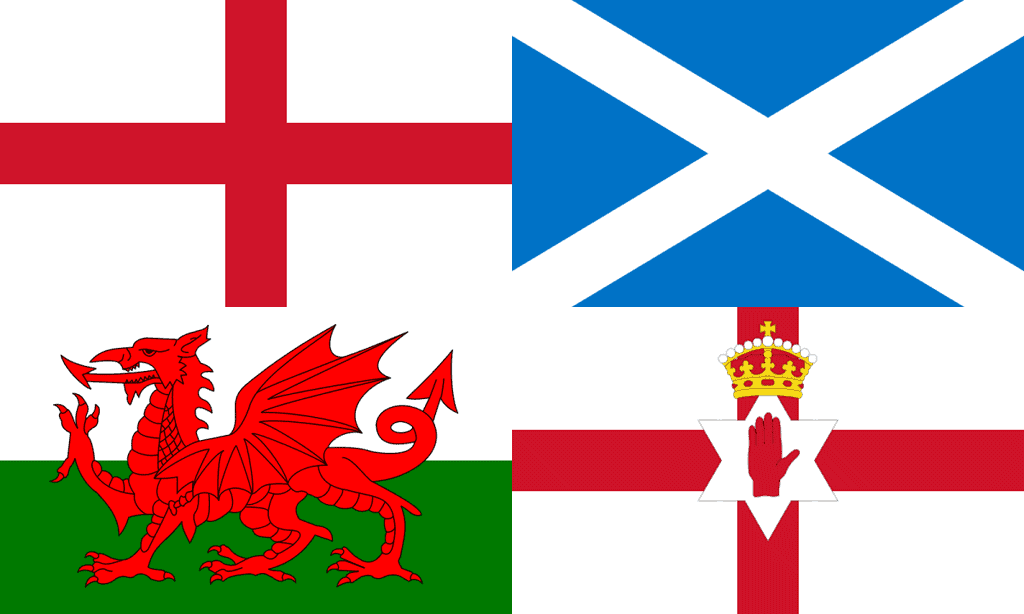


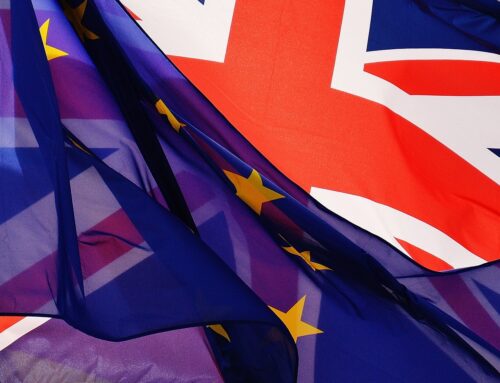


I regret campaigning for devolution in Scotland in 1997, because it has not been rolled out on basis of equality throughout UK. I’ve spent my life back & forth between Scotland and Yorkshire, which have similar population size, but the privileging of the ‘nation’ label over treating human beings as equal has turned Scotland (and Wales and NI) into latter-day Rotten Boroughs, with more powers than other areas of similar pop size.
We should be abolishing the concept of nation-states, not exhuming them to gerrymander results. I studied, lived and worked in Scotland for 29 of my 56 years, In 2014, Yes campaigners told me that I “didn’t deserve a referendum vote because I wasn’t born there” – because I didn’t want an international border imposing through my family, my selfhood or between me and my ailing, recently widowed Scots father who lived in my Mum’s Yorkshire hometown. I lived in Scotland when I voted Remain – but I would have voted the same way wherever I lived: my European identity is not based on a glorified postcode lottery. As I moved down to Yorkshire when my father was dying in 2017, why should I or my Remain vote be treated as worth less? There are 13 million Remainers in England alone – more than double the entire human population of Scotland; indeed, more than the entire population of all other parts of the UK combined.
The thousands, if not millions of us, whose lives, families and identities span more than one part of the UK are being treated as collateral damage by nationalists – it’s as if we don’t exist. I don’t accept the idea that geographical accident or accident of parentage should make half my family ‘more deserving’ of EU citizenship than the rest, regardless of their actual opinions; that a vote in Scotland should be treated as worth 10 or 11 votes in England “because nation’. I am not halves of a person. Members of my own family are not too ‘other’ to be part of same polity, have shared democratic voice.
Equality must be based on treating human beings and their votes as of equal worth wherever they live. We need devolution based on equal-pop-sized départements, not overprivileging ‘nations’ that are smaller than some conurbations or counties..